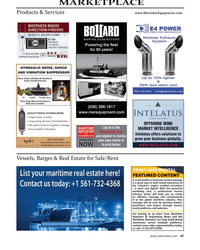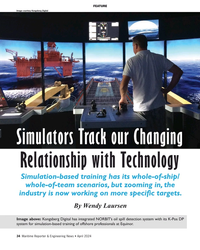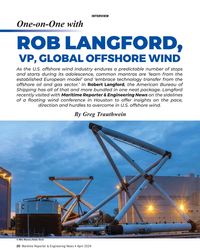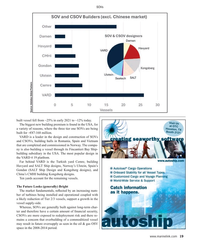Fuel Oil Vent Mechanisms
-
- McAllister Avoids a Date with the Drydock Marine News, Mar 2014 #33
Unconventionally lowering costs, safely and improving the bottom line. That’s the Victaulic way.
In the towing segment of the marine industry, sometimes it does seem that boats are under perpetual repair. A tugboat that’s tied up in maintenance and not able to work is a lost revenue opportunity. As a result, limiting time out of service by performing repair and retrofit services dockside is of critical importance. For example, McAllister Towing & Transportation was able to accomplish repairs not just quickly, but at a lower cost and in a safer manner than conventional methods. That’s just one way that a 150-year old workboat operator can optimize its fleet operations. It turns out that you can, too.
The McAllister Story
You don’t stay in business for one and one-half centuries unless you continually find new and better ways to run a more efficient operation. Founded in 1864, McAllister Towing & Transportation is one of the oldest and largest family-owned marine towing and transportation companies in the United States. The company operates a fleet of more than 70 tugboats and barges in 17 locations along the eastern seaboard, from Portland, Maine, to San Juan, Puerto Rico. Their mission mix runs the gamut from ship docking, general harbor towing, coastal towing and bulk transportation in each port.
McAllister operates three tugs out of Baltimore, including the Robert E. McAllister, a harbor assist tractor tug. Built in 1969 by Peterson Builders of Sturgeon Bay, Wisconsin, the Robert was originally a United States Navy vessel, the USS Nanticoke (YTB-803). Launched on December 14, 1969, she was eventually struck from the Naval Register in 1999, and, in 2002, sold through the Defense Reutilization and Marketing Service to Nix’s Mate Equipment Company of Salem, New Hampshire, where she was renamed as the Canal Protector.
McAllister later acquired and renamed the tug the Robert E. McAllister. In 2005, she was rebuilt. Two Caterpillar 3516B diesel engines replaced her single Fairbanks-Morse engine, and the rudder and propeller were replaced with a pair of Schottel SRP 1012 Z-drives for a rated 4,000 horsepower.
A Quick Fix for Leaky Couplings
Not surprisingly, and despite all of the upgrades performed by McAllister, a bolted sleeve type coupling on the Robert’s engine cooling water supply line sprung a leak, and maintenance personnel needed a way to fix it quickly, once and for all. It wasn’t the first time that joint had leaked, and if they tightened it as they had in the past, there was no guarantee the seal—or for that matter, the coupling—would hold. The particular type of coupling used on that and other engine cooling water lines in the McAllister fleet is a non-restrained coupling, meaning there’s nothing to hold the coupling in place on the joint. On another McAllister tug, the same type of coupling slipped and started to flood the engine room.
In need of a better, long-term solution, port engineer Carlo Parrotta investigated his options. Limiting the tug’s time out of service was the most important factor, so complete replacement of the line wasn’t an option at the time. Parrotta explained, “I was considering welding the pipe. But the problem was that I didn’t have the luxury to go into the drydock. I didn’t have an extreme length of time to go about the service.” Replacement with the same or a similar type of coupling was certainly an option, but would have required a harness to be installed to prevent the coupling from slipping. It also would have made it more difficult to service the systems surrounding it.
In this case, Parrotta was familiar with mechanical pipe-joining systems manufacturer Victaulic, having used its products in previous roles throughout his 25-year career in the maritime industry, so he called the company to see if it could supply a solution. Company representatives visited the Robert to review the application and specs, and recommended the Style 99 Plain End Roust-A-Bout Coupling to replace the bolted sleeve couplings.
Meet the Style 99
The Style 99 is a rigid coupling that has integral hardened carbon steel “teeth” that bite into the outer diameter of each pipe-end, providing the steel-to-steel engagement Parrotta desired. Positive engagement of the pipe is achieved when the bolts are torqued to specification, as marked on the coupling housing. No special pipe preparation—beyond ensuring a smooth, debris-free surface at the pipe-ends—is required prior to assembly.
The Style 99 has multiple IACS type approvals and is Coast Guard approved. ABS type approvals cover fresh water systems; sea water cooling; ballast systems; vents, overflows and sounding pipes; potable water systems; and fire main systems. Plain-end couplings such as the Style 99 are advantageous for retrofit and repair services because there’s little upfront tooling cost. The lack of extensive pipe-end preparation means the coupling can be installed quickly, limiting downtime, which also met Parrotta’s needs. As a result, McAllister decided to move forward with the repair using the Style 99 couplings.
The Fix
To complete the repair, the bolted sleeve couplings were disassembled and removed, the pipe was pulled from the hangers, and the pipe-ends were cleaned of scaling, rust and paint where the new couplings would be installed. The pipe was then repositioned and the Style 99 couplings were assembled on the joints. The repair was completed dockside in just over an hour.
Parrotta, who installed the couplings himself, remarked that the installation process was very simple. It did not require him to bring in a certified welder and deal with the safety hazards and other considerations welding in the space would have posed. Avoiding hot works meant there was no need to clean the surrounding area of standing oil or oil vapors, no need for a fire watch, and no need for weld inspection.
Eliminating welding also meant significant cost savings. Instead of paying a welder for an eight-hour day, the cost was limited to the price of the couplings, which was well within the repair budget. In fact, the savings allowed Parrotta to purchase more units than he needed for the repair on the Robert, and he’s now in the process of replacing—as time and opportunity allow—the same bolted sleeve couplings with Victaulic Style 99 couplings on other McAllister tugs. Furthermore, Parrotta is using the Style 99 coupling for other applications where the cost savings are even more substantial, such as fuel oil vent lines.
Fleet Optimization Defined: Safer, Cheaper Maintenance
When a leak developed at the base of a fuel oil tank vent line on the Robert E. McAllister, it potentially meant thousands of dollars in repair costs. The process could have involved drydocking the boat, emptying the fuel tank, cleaning the tank, calling in a marine chemist to confirm that it’s safe to weld, cutting the pipe and welding to complete the repair. Instead, McAllister’s Parrotta was able to cold-cut the pipe, cap the fuel end of the pipe, and use a torch to remove the remaining portion on the deck and install the new section of prefabricated pipe. Hot work was avoided by completing the on-board connections with the Style 99 couplings, and all work was completed dockside.
“I saved myself several thousand dollars on a marine chemist, several thousand dollars on cleaning the tanks, and the aggravation of waiting several years until the next drydock,” Parotta said, adding, “If you add all these costs, I would have been, conservatively, $15,000 in the hole—all that, just to weld a little hole. When you’re doing all this, the boat is not available for work. By doing it the way we did, it was a fraction of the cost and it took us three hours to do it, compared to probably a week.”
Parrotta adds that the fuel oil vent mechanisms are notoriously difficult to work with. Being above deck and exposed to salt water, varying weather conditions and damage, the vents need constant maintenance as well as testing to ensure proper function. The mechanisms don’t get serviced very often—usually every four to five years at drydock time. During that time, the threaded joints are susceptible to rust and are typically covered in multiple coats of paint, making the vents extremely difficult to remove.
Based on the success of previous applications of the Style 99 couplings, Parrotta decided to ease future maintenance of the fuel oil vent mechanisms by cutting and rejoining the pipes with Victaulic plain-end couplings. This allows personnel to remove the vent for servicing by simply loosening two bolts and removing the coupling from the joint. Reinstallation is as quick as the initial installation. “It makes our job effortless,” said Parrotta, adding that he has completed this work on two of the three tugboats based in Baltimore, and is recommending it to other McAllister port engineers.
Proven Performance = Economy of Scale
The Victaulic Style 99 Plain End Roust-A-Bout Coupling has proven advantageous for McAllister Towing & Transportation in multiple ways, from reducing time out of service, to limiting repair costs and safety hazards. Parrotta said of the solution: “My goal is to do the job as efficiently and safely as possible, and with the least amount of stress and time. If I save time, I save money for the company and reduce the time the tug is not available to do its job. And it’s being done safely, and with a reliable product. I’m happy. I’ve been using [Victaulic couplings] for years, and I’ve never had a problem.” Optimizing his fleet – that’s job ONE for Parotta. For over 150 years, McAllister has been coming up with similar solutions to their operational issues. So can you.
(As published in the March 2014 edition of Marine News - www.marinelink.com)
-
 )
March 2024 - Marine Technology Reporter page: 45
)
March 2024 - Marine Technology Reporter page: 45and the ? exibility for ship or port-to- port mission deployments. Cellula’s Solus-LR and Solus- XR platforms will be equipped with Cellula’s hydrogen fuel cell technology, supporting sustainable, long duration operations with zero carbon emissions • Teledyne Marine Acquires Valeport Teledyne Marine agreed
-
 )
March 2024 - Marine Technology Reporter page: 42
)
March 2024 - Marine Technology Reporter page: 42NEW TECH OCEANOLOGY INTERNATIONAL 2024 Image courtesy Greg Trauthwein Image courtesy BIRNS MacArtney launches the new ultra-compact ø12.7 mm SubConn Nano connector. Innovative connectivity built on 45 years of ? eld-proven and market-trusted design. Image courtesy MacArtney Birns celebrated its 70th
-
 )
March 2024 - Marine Technology Reporter page: 39
)
March 2024 - Marine Technology Reporter page: 39Photo courtesy Global Ocean Design Figure 7 A 35Ah AGM lead-acid battery is tested using the West Mountain Radio CBA to show the effect of simply ? lling the battery voids with mineral oil as a compensating ? uid. The CBA is programmed to cut-off at a voltage of 10.50v. The top line (red) shows the
-
 )
March 2024 - Marine Technology Reporter page: 37
)
March 2024 - Marine Technology Reporter page: 37miscible barrier ? uid heavier than seawater (sg=1.026) and lighter than the battery electrolyte (sg=1.265). The original cell vent cap was screwed into the top of the riser pipe to vent the gases associated with charging. Wires were soldered to the lead (Pb) posts. The lead-acid battery was additionall
-
 )
March 2024 - Marine Technology Reporter page: 36
)
March 2024 - Marine Technology Reporter page: 36LANDER LAB #10 Of special interest for marine applications, LiPo batteries are Shipping any kind of lithium battery can be a challenge, and offered in a “pouch” design, with a soft, ? at body. The pouch IATA regs vary with the batteries inside or outside an instru- is vacuum-sealed, with all voids ?
-
 )
March 2024 - Marine Technology Reporter page: 35
)
March 2024 - Marine Technology Reporter page: 35Figure 1 A self-righting vehicle design with buoyancy high and weight low, WHOI’s SeaBED AUV captures the attention of a pair of curious Antarctic penguins as it is deployed from the British research vessel James Clark Ross. Vehicle designers allowed for temperature reduction of battery capacity. Recharge
-
 )
March 2024 - Marine Technology Reporter page: 33
)
March 2024 - Marine Technology Reporter page: 33regulated industry in the world.” How- ever, commercial success depends on many factors, not least a predictable OPEX. Over the past four years, SMD has worked with Oil States Industries to calculate cost per tonne ? gures for prospective customers. Patania II uses jet water pumps to Oil States’
-
 )
March 2024 - Marine Technology Reporter page: 23
)
March 2024 - Marine Technology Reporter page: 23elatively inactive since 2014, the Hunga Tonga–Hunga Ha‘apai (HT-HH) submarine volcano began erupting on December 20, 2021, reaching peak intensity on January 15, 2022. This triggered tsunamis throughout the Pa- R ci? c, destroyed lives and infrastructure, and generated the largest explosion recorded
-
 )
March 2024 - Marine Technology Reporter page: 18
)
March 2024 - Marine Technology Reporter page: 18TECH FEATURE IMR There are also weaknesses in terms of accuracy because of FiGS Operations and Bene? ts signal noise and the ability to detect small ? eld gradients. In Conventional approaches to evaluating cathodic protection this process there is a risk that possible issues like coating (CP)
-
 )
April 2024 - Maritime Reporter and Engineering News page: 47
)
April 2024 - Maritime Reporter and Engineering News page: 47MARKETPLACE Products & Services www.MaritimeEquipment.com Powering the fleet for 60 years! HYDRAULIC NOISE, SHOCK AND VIBRATION SUPPRESSOR Noise, Shock, VibraO on & PulsaO on in Quiet, Smooth Flow Out Oil Bladder Nitrogen (blue) Manufactured by MER
-
 )
April 2024 - Maritime Reporter and Engineering News page: 43
)
April 2024 - Maritime Reporter and Engineering News page: 43for the decarbonization. New energy saving devices, alterna- design, planning and testing of ships, “I don't say that crews must be soft- tive fuels, carbon capture, batteries and and a regulatory framework which takes ware engineers, but there is no going fuel cell power will all provide critical
-
 )
April 2024 - Maritime Reporter and Engineering News page: 41
)
April 2024 - Maritime Reporter and Engineering News page: 41Nautel provides innovative, industry-leading solutions speci? cally designed for use in harsh maritime environments: • GMDSS/NAVTEX/NAVDAT coastal surveillance and transmission systems • Offshore NDB non-directional radio beacon systems for oil platform, support vessel & wind farm applications
-
 )
April 2024 - Maritime Reporter and Engineering News page: 39
)
April 2024 - Maritime Reporter and Engineering News page: 39at Fjord Base in Florø, Norway. Azane’s efforts to make low-emission ammonia a common The planned terminal consists of a ? oating stationary barge fuel for shipping. With ammonia’s potential to fully decar- with a capacity of 1000 cubic meters, or 650 tons, of am- bonize the maritime sector, the companies
-
 )
April 2024 - Maritime Reporter and Engineering News page: 38
)
April 2024 - Maritime Reporter and Engineering News page: 38. Images courtesy Consulmar Crowley's New LNG Containerships Carbon Capture @ Sea Crowley shared ? rst renderings and the names of its four new dual fuel lique? ed natural gas (LNG)-powered containerships: Quetzal, Copan, Tiscapa and Torogoz. The 1,400 TEU ves- sels were ordered in 2022 by Singapore-based
-
 )
April 2024 - Maritime Reporter and Engineering News page: 35
)
April 2024 - Maritime Reporter and Engineering News page: 35. One of the most important is the familiar- for a new maritime training center in Finland that will have ization of the crew with new and emerging fuels and technol- two engine room simulators along with two large and three ogy. For example, the industry has well-established experience medium sized
-
 )
April 2024 - Maritime Reporter and Engineering News page: 34
)
April 2024 - Maritime Reporter and Engineering News page: 34FEATURE Image courtesy Kongsberg Digital Simulators Track our Changing Relationship with Technology Simulation-based training has its whole-of-ship/ whole-of-team scenarios, but zooming in, the industry is now working on more speci? c targets. By Wendy Laursen Image above: Kongsberg Digital has integrated
-
 )
April 2024 - Maritime Reporter and Engineering News page: 32
)
April 2024 - Maritime Reporter and Engineering News page: 32(in yellow). Images courtesy of Mammoet requirement for the development of these cranes, particularly ling area. This would result in a major time and fuel saving. in ? oating offshore wind,” says Adrian Green, Engineering & For ? oating projects, it could reduce project installation time Contracts
-
 )
April 2024 - Maritime Reporter and Engineering News page: 28
)
April 2024 - Maritime Reporter and Engineering News page: 28expeditionary transfer docks (ESDs) and four expeditionary sea base ships. We also have two offshore petro- leum distribution system ships that help move fuel ashore. Another ten preposition ships support the Army and Air Force. It should be pointed out that we can build adaptive force packages to be placed
-
 )
April 2024 - Maritime Reporter and Engineering News page: 27
)
April 2024 - Maritime Reporter and Engineering News page: 27that it is and Clark class dry cargo and ammunition ships that deliver will help us to retain them. Unfortunately, we can’t guaran- ammo, food, parts and fuel. We have two big fast combat sup- tee everyone their choice of ship assignment because we just port ships (T-AOEs), that are fast enough to keep up
-
 )
April 2024 - Maritime Reporter and Engineering News page: 25
)
April 2024 - Maritime Reporter and Engineering News page: 25RADM PHILIP SOBECK, MILITARY SEALIFT COMMAND Photo by Brian Suriani USN Military Sealift Command From a global supply chain perspective, What makes MSC so vital to the we’ve learned a lot about dealing with Navy’s ? eet and our military disruptions. COVID delivered a big forces around the world? wake-up
-
 )
April 2024 - Maritime Reporter and Engineering News page: 21
)
April 2024 - Maritime Reporter and Engineering News page: 21ROB LANGFORD, VP, GLOBAL OFFSHORE WIND ob Langford has worked in the offshore industry ABS. “We are growing and evolving our services across all for more than three decades, ‘cutting his teeth’ offshore infrastructure along with our continued support to the in a UK design ? rm working in the North Sea
-
 )
April 2024 - Maritime Reporter and Engineering News page: 20
)
April 2024 - Maritime Reporter and Engineering News page: 20INTERVIEW One-on-One with ROB LANGFORD, VP, GLOBAL OFFSHORE WIND As the U.S. offshore wind industry endures a predictable number of stops and starts during its adolescence, common mantras are ‘learn from the established European model’ and ‘embrace technology transfer from the offshore oil and gas
-
 )
April 2024 - Maritime Reporter and Engineering News page: 19
)
April 2024 - Maritime Reporter and Engineering News page: 19SOVs Source: Intelatus Global Partners built vessel fell from ~25% in early 2021 to ~12% today. Visit Us The biggest new building premium is found in the USA, for at OTC Houston, TX a variety of reasons, where the three tier one SOVs are being Booth 2121 built for ~€87-168 million. VARD is a leader in
-
 )
April 2024 - Maritime Reporter and Engineering News page: 18
)
April 2024 - Maritime Reporter and Engineering News page: 18SOV emissions reduction measures, more than 20 active or under and three Tier 1 CSOVs in construction for the comparatively construction vessels feature fuel ? exibility through dual fuel near shore Taiwanese market, which is also actively served by engines and (space for) a bunkering system. Currently
